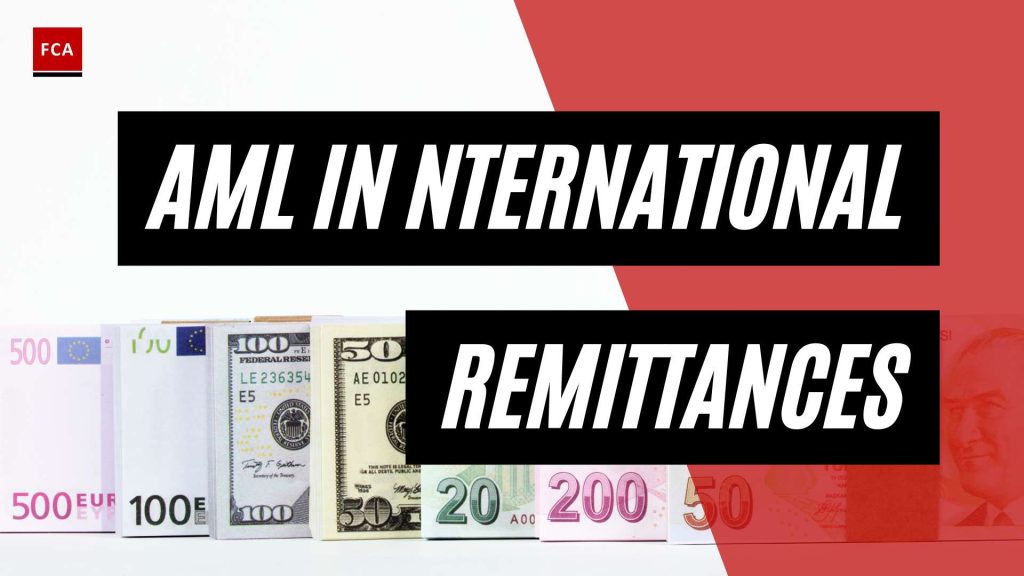Globalization and AML Challenges in International Remittances
The increasing globalization of financial transactions has brought about unique challenges in ensuring Anti-Money Laundering (AML) compliance in international remittances. Financial institutions are under growing pressure from regulators to implement robust AML measures in order to prevent money laundering and terrorist financing. Non-compliance with AML regulations can result in severe penalties and fines.
Importance of AML Compliance in International Remittances
AML compliance is of paramount importance in international remittances to safeguard the financial system from illicit activities. Criminals often exploit cross-border transactions to launder money or finance illegal activities. Financial institutions play a critical role in detecting and preventing these illicit activities by adhering to AML regulations.
Regulatory bodies, such as the Financial Action Task Force (FATF), have established stringent rules and guidelines to combat money laundering and terrorist financing in international remittances. These regulations emphasize the need for financial institutions to implement comprehensive AML compliance programs to identify and report suspicious transactions.
Regulatory Framework for AML Compliance in International Remittances
To ensure AML compliance in international remittances, financial institutions must adhere to the regulatory framework established by organizations like the FATF and the Financial Crimes Enforcement Network (FinCEN) (ComplyAdvantage). These frameworks provide guidelines and requirements that financial institutions must follow to combat money laundering risks.
The FATF, a global standard-setter in AML and counter-terrorist financing efforts, has identified vulnerabilities in the remittance industry and emphasized the importance of implementing appropriate AML compliance measures (ComplyAdvantage). Financial institutions must develop risk-based AML compliance programs, assess customer risks, and implement appropriate AML measures in alignment with FATF recommendations.
In the United States, FinCEN has played a crucial role in ensuring AML compliance in the international remittance industry since 2011 (GAO). FinCEN enforces AML requirements applicable to remittance service providers and monitors their compliance with regulatory obligations.
By adhering to the regulatory frameworks established by organizations like the FATF and FinCEN, financial institutions can contribute to the global efforts to combat money laundering and terrorist financing in international remittances. These frameworks provide the necessary guidance and standards for implementing effective AML compliance programs and mitigating the risks associated with cross-border financial transactions.
Emerging Trends in AML Compliance for International Remittances
As international remittances continue to grow in a globalized world, it becomes imperative to address the challenges of ensuring effective Anti-Money Laundering (AML) compliance. To stay ahead of financial criminals and regulatory requirements, financial institutions are adopting emerging trends and advanced technologies to enhance their AML compliance efforts in international remittances.
Adoption of Advanced Technologies
Financial institutions are required to implement robust AML compliance programs that apply sophisticated data analytics and machine learning models to monitor, detect, and report suspicious transactions in international remittances. By leveraging artificial intelligence and machine learning, these technologies enable financial institutions to analyze vast amounts of transactional data in real-time, identifying patterns and anomalies that could indicate potential money laundering activities.
The adoption of advanced technologies offers several advantages for AML compliance in international remittances. It enhances the effectiveness and efficiency of monitoring systems, allowing for more accurate and timely detection of suspicious transactions. These technologies can also adapt to evolving money laundering techniques and regulatory requirements, helping financial institutions stay proactive in their compliance efforts.
Continuous Updating and Optimization of AML Compliance Programs
AML compliance programs for international remittances should not be static. Instead, they should be continuously updated and optimized to address emerging risks and regulatory changes. It is essential for financial institutions to stay informed about the latest trends, typologies, and red flags associated with money laundering in the remittance sector.
To maintain ongoing AML compliance efficiently, remittance service providers can streamline their data collection and analysis needs by incorporating smart AML software. These software solutions enhance the speed, accuracy, scalability, and adaptability of the compliance processes, enabling financial institutions to keep pace with the evolving nature of money laundering activities and regulatory expectations (ComplyAdvantage).
By continuously updating and optimizing their AML compliance programs, financial institutions can effectively mitigate the risks associated with money laundering in international remittances. Regular training and awareness programs for employees also play a crucial role in ensuring that they are well-equipped to identify and report suspicious activities.
The adoption of advanced technologies and the continuous updating of AML compliance programs are key strategies for financial institutions to enhance their capabilities in combating money laundering in the realm of international remittances. These trends enable financial institutions to strengthen their defenses against financial criminals and meet the evolving AML regulatory landscape.
In the next section, we will explore how financial institutions can enhance their AML compliance efforts through robust AML compliance programs and the application of artificial intelligence and machine learning technologies.
Enhancing AML Compliance in International Remittances
To effectively combat money laundering in international remittances, financial institutions are required to implement robust AML (Anti-Money Laundering) compliance programs. These programs play a crucial role in preventing illicit funds from being transferred across borders and ensure regulatory compliance.
Robust AML Compliance Programs
In order to meet the challenges posed by money laundering and meet regulatory requirements, financial institutions need to establish robust AML compliance programs. These programs should incorporate sophisticated data analytics and utilize machine learning models to monitor, detect, and report suspicious transactions in international remittances (Tookitaki). By leveraging advanced technologies, financial institutions can enhance the effectiveness and efficiency of their AML compliance efforts.
One of the key benefits of robust AML compliance programs is their ability to identify and flag potential money laundering activities in cross-border transactions. By analyzing transactional data, these programs can detect patterns, anomalies, and red flags that may indicate illicit financial activities. This proactive approach helps in preventing money laundering and enables financial institutions to take appropriate action to mitigate risks.
Role of Artificial Intelligence and Machine Learning
Emerging technologies like artificial intelligence (AI) and machine learning (ML) have become integral to enhancing AML compliance in international remittances. These technologies enable financial institutions to stay ahead of financial criminals and regulatory requirements (Tookitaki). By automating processes and analyzing vast amounts of data, AI and ML algorithms can identify complex patterns and detect suspicious activities that may go unnoticed by traditional manual methods.
AI and ML algorithms can continuously learn and adapt to evolving money laundering techniques, making them effective tools in the fight against financial crime. These technologies can analyze transactional data, customer profiles, and other relevant information to identify potential risks and generate alerts for further investigation. The use of AI and ML in AML compliance programs enables financial institutions to streamline their processes, reduce false positives, and allocate resources more efficiently.
By incorporating AI and ML into their AML compliance programs, financial institutions can enhance their ability to detect and prevent money laundering in international remittances. These technologies provide a powerful means to analyze vast amounts of data, identify suspicious activities, and ensure compliance with regulatory requirements.
To maintain ongoing AML compliance efficiently, remittance service providers can also streamline their data collection and analysis needs by incorporating smart AML software. This software enhances the speed, accuracy, scalability, and adaptability of the compliance processes, enabling financial institutions to effectively address the challenges of international remittances.
In the next section, we will explore the importance of identifying suspicious activities and discuss the compliance challenges and solutions associated with AML compliance in international remittances.
Reducing Money Laundering Risks in International Remittances
To combat the risks associated with money laundering in international remittances, it is crucial to focus on identifying suspicious activities and addressing the compliance challenges that arise in this context.
Identifying Suspicious Activities
Financial institutions need to be vigilant in identifying suspicious activities that may indicate potential money laundering in international remittances. Some red flags that may warrant further investigation include:
- Transactions involving large amounts of cash or private funding, as these could indicate attempts to conceal the source of funds.
- Involvement of politically exposed persons (PEPs), such as heads of state, senior politicians, and government officials, who may be more vulnerable to corruption and quid-pro-quo arrangements.
- Unexplained connections and movement of funds between different jurisdictions, which may raise suspicions and require closer scrutiny.
- Companies utilizing complex ownership structures or shell companies to disguise criminal activities and facilitate financial crime (ComplyAdvantage).
- Regularly reviewing international sanctions lists to ensure customers are not sanctioned or engaging in transactions with sanctioned entities (ComplyAdvantage).
By closely monitoring and analyzing these and other potential indicators of money laundering, financial institutions can proactively detect and report suspicious activities, contributing to a robust AML compliance program.
Compliance Challenges and Solutions
Implementing effective AML compliance programs in international remittances presents several challenges. Financial institutions need to navigate complex regulatory frameworks and ensure their programs remain up to date with evolving financial crimes. Additionally, streamlining data collection and analysis can be challenging due to the volume and diversity of remittance transactions.
To address these challenges, financial institutions should consider the following solutions:
-
Robust AML Compliance Programs: Financial institutions must develop and implement comprehensive AML compliance programs tailored to international remittances. These programs should apply sophisticated data analytics and machine learning models to monitor, detect, and report suspicious transactions (Tookitaki). Regular assessments and updates to these programs are essential to adapt to changing regulatory requirements and emerging risks.
-
Role of Artificial Intelligence and Machine Learning: The adoption of advanced technologies, such as artificial intelligence and machine learning, can significantly enhance the effectiveness and efficiency of AML compliance efforts in international remittances. These technologies enable financial institutions to analyze vast amounts of data, identify patterns, and detect suspicious activities in real-time. By leveraging AI and ML, institutions can stay ahead of financial criminals and regulatory requirements (Tookitaki).
By implementing robust AML compliance programs and leveraging advanced technologies, financial institutions can mitigate money laundering risks in international remittances. Regular training and awareness programs can also help employees understand the importance of identifying suspicious activities and adhering to compliance measures. Collaboration and information exchange among financial institutions and regulatory bodies further contribute to reducing these risks, as explored in the next section.
Regulatory Framework for AML Compliance in International Remittances
To combat money laundering and terrorist financing risks associated with international remittances, regulatory bodies have established a comprehensive framework of guidelines and requirements for financial institutions. Two prominent entities involved in shaping the regulatory landscape are the Financial Action Task Force (FATF) and the Financial Crimes Enforcement Network (FinCEN).
Financial Action Task Force (FATF) Guidelines
The Financial Action Task Force (FATF) plays a pivotal role in promoting global AML compliance standards. It is an intergovernmental body focused on developing and implementing policies to combat money laundering and terrorist financing at both national and international levels. FATF has issued guidelines that financial institutions, including remittance service providers, must adhere to in order to prevent money laundering and terrorist financing through international remittances.
FATF emphasizes the importance of risk-based AML compliance programs, which require financial institutions to assess the risks associated with their customers and transactions. This assessment helps in evaluating the potential money laundering risks and implementing appropriate AML measures in accordance with FATF recommendations (ComplyAdvantage).
Role of Financial Crimes Enforcement Network (FinCEN)
In the United States, the Financial Crimes Enforcement Network (FinCEN) assumes a key role in ensuring compliance with AML requirements in the international remittance industry. Since 2011, FinCEN has been responsible for overseeing and enforcing AML regulations applicable to the industry.
FinCEN provides guidance to financial institutions involved in international remittances through advisories, rulemakings, and frequently asked questions (FAQs). This guidance helps institutions better understand and implement AML requirements specific to the international remittance sector. By clarifying regulatory expectations, FinCEN assists financial institutions in identifying and mitigating money laundering risks associated with international remittances.
By adhering to the guidelines and regulations set forth by FATF and FinCEN, financial institutions can ensure robust AML compliance programs that effectively address the unique challenges posed by international remittances. These regulatory frameworks serve as a framework for financial institutions to strengthen their AML practices and contribute to the global efforts in combating money laundering and terrorist financing.
Compliance Challenges in International Remittances
As global financial systems become increasingly interconnected, the challenges related to Anti-Money Laundering (AML) compliance in international remittances have become more complex. To effectively combat money laundering and meet regulatory requirements, financial institutions and remittance service providers must navigate a range of compliance challenges. Two key challenges in this domain are implementing risk-based AML compliance programs and streamlining data collection and analysis.
Implementing Risk-Based AML Compliance Programs
Financial institutions and remittance service providers are required to develop risk-based AML compliance programs to mitigate money laundering risks associated with international remittances. These programs involve assessing customers and transactions to evaluate the level of risk and implementing appropriate preventive measures. The Financial Action Task Force (FATF) necessitates that member countries develop risk-based AML compliance programs for financial institutions, including remittance service providers, as outlined in their recommendations (ComplyAdvantage).
By conducting thorough customer due diligence, financial institutions can identify and verify the identity of their clients. This includes assessing the purpose and nature of the remittance transactions and monitoring for any unusual or suspicious activities. Implementing effective know your customer (KYC) procedures and transaction monitoring systems enables financial institutions to detect and report potential money laundering activities. These risk-based AML compliance programs enhance the overall integrity of international remittances and help protect the global financial system from illicit funds.
Streamlining Data Collection and Analysis
To maintain ongoing AML compliance efficiently, remittance service providers can streamline their data collection and analysis processes. Incorporating smart AML software enhances the speed, accuracy, scalability, and adaptability of compliance processes (ComplyAdvantage). This software automates data collection from various sources, such as transaction records, customer profiles, and external data feeds, facilitating the compilation of comprehensive data sets for analysis.
By leveraging advanced data analytics and machine learning models, remittance service providers can identify patterns, trends, and anomalies in transactional data, enabling them to effectively detect potential money laundering activities. These technologies assist in the identification of suspicious transactions, ensuring timely reporting to the relevant authorities. Streamlining data collection and analysis not only improves the efficiency of AML compliance efforts but also strengthens the capability to safeguard international remittances from illicit financial activities.
To maintain compliance with AML regulations and combat money laundering risks in international remittances, financial institutions and remittance service providers must address these challenges. By implementing risk-based AML compliance programs and leveraging advanced technologies for data collection and analysis, they can enhance the integrity and security of international remittance transactions while meeting regulatory requirements.
Importance of Collaboration and Information Exchange
In the realm of AML compliance, collaboration and information exchange play a crucial role in addressing the challenges associated with international remittances. Strengthening international cooperation and addressing AML challenges are key aspects of promoting a more effective and robust AML compliance framework.
Strengthening International Cooperation
The importance of international cooperation cannot be overstated when it comes to combating money laundering risks in the context of international remittances. The Basel Institute on Governance emphasized the need for enhancing the exchange of information and cooperation among authorities to strengthen AML compliance efforts in the remittance sector (Bank for International Settlements). By working together across borders, regulatory authorities can effectively address the evolving nature of money laundering and terrorist financing activities.
International cooperation enables the sharing of best practices, knowledge, and intelligence, allowing regulatory bodies to stay ahead of emerging trends and techniques employed by criminals. Through collaborative efforts, countries can enhance their AML frameworks, streamline processes, and foster a more coordinated approach to combatting financial crimes.
Addressing AML Challenges in Remittances
The remittance sector is particularly vulnerable to money laundering risks due to the high volume and nature of transactions involved. Regulatory authorities often encounter challenges in enforcing AML and CFT requirements in this sector, highlighting the need for effective solutions and compliance measures (Bank for International Settlements). To address these challenges, stakeholders must prioritize collaboration and information sharing.
By exchanging information and collaborating with domestic and international partners, regulatory bodies can gain valuable insights into the latest trends, typologies, and red flags associated with money laundering and terrorist financing activities. This information exchange facilitates the development of more robust AML compliance programs and enables better risk assessment and mitigation strategies.
Furthermore, collaborative efforts enhance the ability to detect and investigate suspicious activities across borders. By sharing intelligence and coordinating investigations, regulatory authorities can dismantle complex money laundering networks and disrupt illicit financial flows.
To facilitate effective collaboration, international bodies such as the Financial Action Task Force (FATF) and the Financial Crimes Enforcement Network (FinCEN) provide guidance and establish frameworks to promote cross-border cooperation in AML efforts. The FATF, through its guidelines, outlines best practices and standards for AML compliance in international remittances. FinCEN, on the other hand, plays a vital role in ensuring compliance with AML requirements in the remittance industry in the United States.
By strengthening international cooperation and promoting the exchange of information, regulatory bodies can address the unique AML challenges posed by international remittances. This collaborative approach fosters a global network of AML compliance professionals working collectively to protect the integrity of the financial system and mitigate the risks associated with money laundering and terrorist financing.
For a comprehensive understanding of the regulatory framework governing AML compliance in international remittances, refer to our sections on Regulatory Framework for AML Compliance in International Remittances and Financial Action Task Force (FATF) Guidelines.








